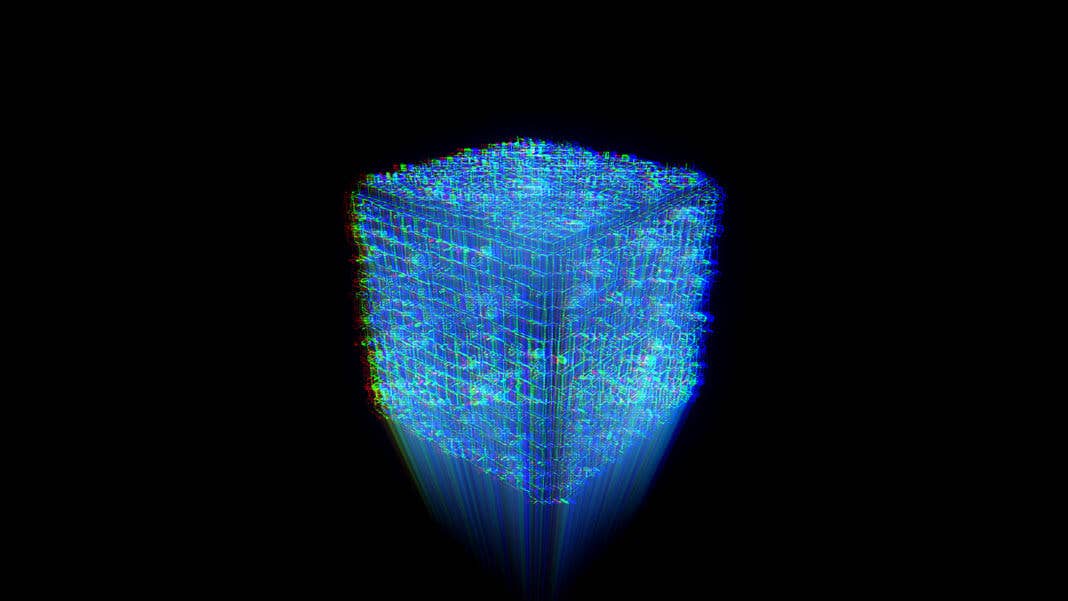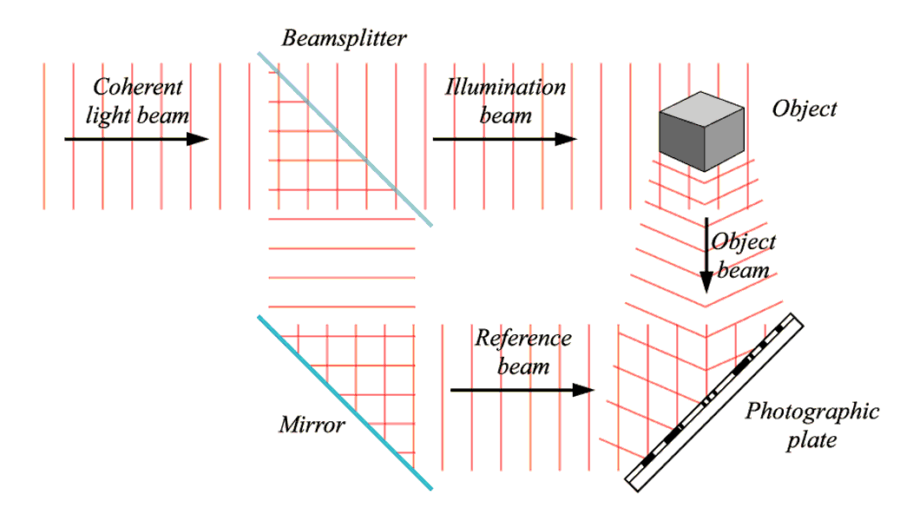Solving a Math Problem Just Brought Holograms Closer to Reality

Share
Holograms are a staple in science fiction, but creating ones detailed enough to have serious applications in the real world has proved difficult. While scientists have been slowly pushing the field of holographic projection forward, they haven’t been able to overcome a problem called cross-talk. However, in a recent paper published in Nature, they have been able to manipulate the shape of light to overcome this, thus allowing them to produce 3D holograms that are orders of magnitude clearer, larger, and more detailed.
What Are Holograms?
Simple holograms are 2D surfaces that produce the illusion of a 3D object when light is shined through it.
These are created by splitting a laser into two beams, bouncing one off an object, bouncing the other off a mirror, and recombining them on a specialized photographic plate.
Lasers are coherent light, meaning they’re composed of one specific frequency, in that all light waves are moving in unison. When two coherent light waves are combined, a process known as interference, an orderly and predictable pattern is produced. The peaks amplify other peaks, the troughs amplify other troughs, and peaks and troughs cancel each other out, thus producing alternating bands of light and dark.
However, when the light is reflected off of an object, it’s no longer coherent, and when it’s recombined with the coherent light of the laser beam, an interference pattern is created that is specific to the object.
The photographic plate is placed exactly where the light is recombined, thus capturing the unique interference pattern, which holds all the information needed to reproduce a 3D image of the object, including the depth cues of perspective and parallax (the difference in the apparent position of an object viewed along two different lines of sight). To reproduce the image of the object, the reference beam needs to be shined through the back of the plate, thus hitting the interference pattern and producing the object beam, as if it has just come off the object.
Put another way, (the reference beam) + (the object beam) = (the interference pattern on the plate), and shining the reference beam in from the other direction is like rearranging this equation so that (the interference pattern on the plate) - (the reference beam) = (the object beam), making the image appear.
The Problems with 3D Holographic Projection
The process described above is used to create only one plate, which holds a limited amount of information, meaning the images produced are low in quality. To create images that are usable in meaningful applications, more plates need to be stacked together, as they can hold more information. The limit to maintain image quality is three to four plates.
This is due to cross-talk, which is when the images created by each plate interfere with each other, thus distorting the overall image. As light is shined through the plates and the images are created, the light from the images in back must pass through the ones in front, altering the light’s synchronized movement, which in turn alters the rest of the light wave, known as Fresnel diffraction. Since the light waves are out of sync, their images become blurred.
Random Phase Approximation
Getting around the problem of Fresnel diffraction has until now involved designing better equipment, but the authors of the new study found a connection between the underlying mathematical theories to completely prevent the phenomenon.
The equations of Fresnel diffraction describe specific cases of light that’s out of phase due to obstructions, such as the multiple plates used in creating a complex hologram. The idea is to transform these into the ideal waveforms described by the equations of Fourier holography.
Be Part of the Future
Sign up to receive top stories about groundbreaking technologies and visionary thinkers from SingularityHub.


The question, then, is how to transform disorderly light into orderly light by transforming Fresnel diffraction equations into those used in Fourier holography.
The answer is random phase approximation (RPA), and this is based on a handful of key ideas.
First, waves are considered “in phase” when their peaks and troughs line up. Waves that are not in phase interfere with each other, thus distorting the image.
Second, each part of a system oscillates at its own frequency, but all of these frequencies average out, creating a system-wide frequency.
Third, when the system-wide frequency of two systems are randomized, there is an extremely high likelihood that they’ll be orthogonal, meaning they’ll be in phase with each other.
The researchers were able to sufficiently randomize the phases of each plate, eliminating any cross-talk between them. Therefore, the light emitting from one plate did not interfere with the light from other plates, creating a crisp, detailed 3D image.
“We demonstrate Fresnel holograms that form on-axis with full depth control without any cross-talk, producing large-volume, high-density, dynamic 3D projections with 1,000 image planes simultaneously,” they said in the paper.
Such detailed 3D holograms can be used in virtually every field, although the researchers believe the most immediate uses will be in medicine and aviation. For example, instead of the 2D images created by MRIs, CT scans, and other medical imaging techniques, doctors and nurses will be able create accurate 3D representations of a patient’s body, making it easier to analyze and diagnose problems. Engineers will be able to use detailed holograms to design and repair aircrafts.
Although it may still be a few years away, once this groundbreaking technique becomes commercially available, it will certainly be a turning point, similar to how x-rays revolutionized medicine.
Image Credit: Vandrage Artist / Shutterstock.com
Scott is currently doing research and editing for the UN. He's most interested in sustainable energy, global politics, and cryptocurrencies. In his spare time, he enjoys reading and being outdoors.
Related Articles

AI Companies Are Betting Billions on AI Scaling Laws. Will Their Wager Pay Off?

Super Precise 3D Printer Uses a Mosquito’s Needle-Like Mouth as a Nozzle

Is the AI Bubble About to Burst? What to Watch for as the Markets Wobble
What we’re reading
